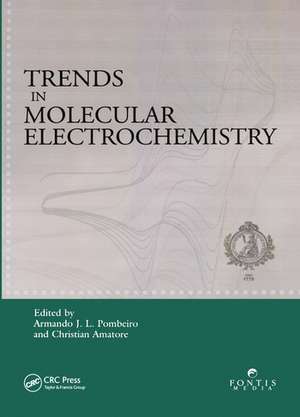Trends in Molecular Electrochemistry
Editat de Armando J.L. Pombeiro, Christian Amatoreen Limba Engleză Paperback – 30 iun 2020
Trends in Molecular Electrochemistry presents recent research on procedures in molecular electroactivation and electrocatalysis, bioelectrochemistry, spectroelectrochemistry, and unconventional electrochemistry. The book highlights the state-of-the-art in the application of electrochemistry by taking an interdisciplinary approach to the study of both static and dynamic molecular properties of coordination compounds as well as inorganic, bioinorganic, and organometallic complexes, supramolecular systems, and metalloenzymes. The principles and approaches are often also valid for organic systems, which are illustrated in various contexts.
Preț: 456.17 lei
Nou
Puncte Express: 684
Preț estimativ în valută:
87.30€ • 90.18$ • 72.65£
87.30€ • 90.18$ • 72.65£
Carte tipărită la comandă
Livrare economică 25 martie-08 aprilie
Preluare comenzi: 021 569.72.76
Specificații
ISBN-13: 9780367578299
ISBN-10: 0367578298
Pagini: 568
Dimensiuni: 174 x 246 x 29 mm
Greutate: 0.93 kg
Ediția:1
Editura: CRC Press
Colecția CRC Press
ISBN-10: 0367578298
Pagini: 568
Dimensiuni: 174 x 246 x 29 mm
Greutate: 0.93 kg
Ediția:1
Editura: CRC Press
Colecția CRC Press
Public țintă
ProfessionalCuprins
Redox and Other Molecular Properties. Molecular Electroactivation. Bioelectrochemistry. Supramolecular Electrochemistry.
Recenzii
"… presents the latest research, using an interdisciplinary approach, in the application of electrochemistry to study various molecular systems."
- Journal of American Chemical Society, 2005
- Journal of American Chemical Society, 2005
Notă biografică
Armando J.L. Pombeiro, Christian Amatore
Descriere
This book presents recent research on procedures in molecular electroactivation and electrocatalysis, bioelectrochemistry, spectroelectrochemistry, and unconventional electrochemistry. World-class contributors investigate techniques used to control the electronic, optical, and magnetic properties of molybdenum complexes by redox active ligands. The
